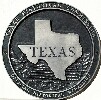
|
Marion County Historical Markers |
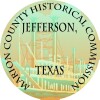
|

|
Marion County Historical Markers |

|
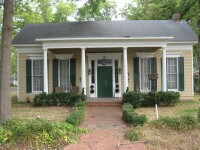
|
Dan N. Alley Home (Alley-Carlson House, Mary Carlson Home) 501 E. Walker St. Built by Dan N. Alley, a founder of Jefferson. Was wedding gift to a son. Later the home of Mary Carlson, a descendant. Recorded Texas Historic Landmark - 1966 |
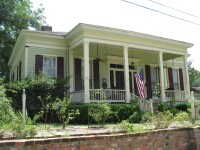
|
Alley-McKay House 306 E. Delta St. Daniel Nelson Alley (1810-68) built this home about 1851. A founder of Jefferson, Alley was a prominent early landowner in Marion County. Several families owned the house before 1884, when Hector McKay (1835-93) bought the property. A veteran of the Civil War, McKay was one of the area's leading attorneys. His son, Arch McKay (1875-1954), retained ownership of the home until his death. Designed in the Greek revival style, it features a 4-room central hall plan. Recorded Texas Historic Landmark - 1986 |
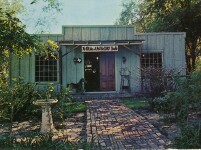
|
Apothecary Shop 312 E. Broadway St. Relics of H. H. Sedberry, 1859 Jefferson druggist, building restored with Caddo Lake cypress wood. Recorded Texas Historic Landmark - 1965 |
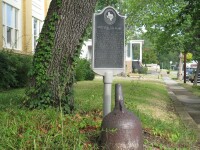
|
Artificial Gas Plant, First Texas Lafayette and Market St. Jefferson Gas Light Company, chartered 1870 for public ;and domestic service, used retorts-- 7 foot iron drums with small necks-- to make illuminating gas. (One retort stood on this site.) Loaded with pine knots and rich pine wood, a retort was heated; its gas was forced into mains by use of a pressure drum. Street lights on hollow posts, 300 feet apart, were 10-candle glass globes, lighted by a man on a ladder. These and gaslights in houses gave Jefferson - then largest inland port and second largest city in Texas - the state's first gaslight system. |
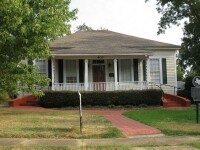
|
Atkins House 407 E. Walker Late Greek revival style house. Probably built in 1860 by T. O. Alley (1836-1860), son of Daniel N. Alley, co-founder of Jefferson. Over the years other notable owners have been james M. Tucker (d. ;1891), steamboatman and captain in 16th Texas Dismounted Cavalry, Confedereate Army; and W. R. Camp, an attorney. Longest ownership (1892-1923) was by W. T. Atkins (1842-1930), official of Jefferson Iron Co. House was acquired in 1961 by Mrs. Nettie Mae Lemmon. Recorded Texas Historic Landmark - 1972 |
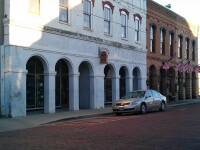
|
Austin Street Mercantile Austin St., across from Courthouse Typical of city's heyday as greatest inland port in southwest. Erected before 1866. Housed offices, grocery, saloon, drugstore. A famous owner was Sallie Harrison, given this building (1882) on her marriage to C. A. Culberson, later to become governor and U. S. Senator. Recorded Texas Historic Landmark - 1970 |

|
Beamer Davis Cemetery Description to come |
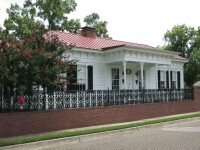
|
Beard House Vale and Henderson St. Built 1860 with kitchen detached, in custom of Old South. Represents cottage type. Recorded Texas Historic Landmark - 1966 |
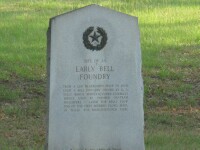
|
Bell Foundry, Early SH 49 and FM 729, 4 mi. from Jefferson 1936 Centennial Marker - From a log blacksmith shop in 1854 grew a bell foundry owned by G. A. Kelly which manufactured cowbells widely used by pioneer ox-team freighters. Later the Kelly plow, one of the first modern plows made in Texas, was manufactured here. |

|
Benefield Sr., J.H., Home 1009 S. Line St. |
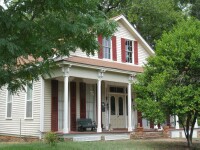
|
Benefield, Barry, Homesite of 909 Line St. (May 12, 1877 - Sept. 22, 1971) Born while Jefferson was a dominant East Texas city, Barry Benefield learned well the character and lore of this region while working at his father's wagon yard, located beside this 1860s house the family had purchased in 1897. Upon his graduation from the University of Texas, Benefield became a journalist and later a novelist. Two of his works, "Chicken Wagon Family" (1925) and "Valiant Is the Word for Carrie" (1935), were made into movies and gave international fame to Jefferson. In retirement, Benefield again lived in this house until his death at the age of 94. |
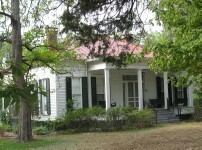
|
Bluebonnett Farm Raised cottage; begun in 1847. Main wing, built 1869, is of heart pine cut on the home place. Recorded Texas Historic Landmark - 1966 |
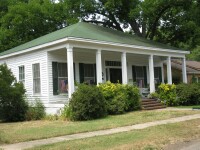
|
Bower, Doyle, House 1005 S. Line St. Typical of early Texas. Constructed with square nails and pegs. Built in 1858 by Haye Zolley. Recorded Texas Historic Landmark - 1966 |

|
Brantly Cemetery Description to come |
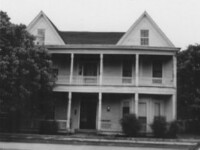
|
Brooks House (Burned) Built 1872 in Victorian style, with long galleries, bay window, 4 gables. Then a hotel, it became famous when guest "Diamond Bessie" Moore was killed west of town at a picnic in 1877. Fellow guest Abe Rothchild, cited for murder, was freed after sensational trial - later subject of a drama. |
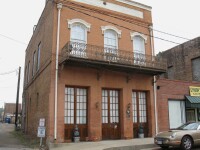
|
Brown Building 112 N. Vale Old home of Jefferson "Jimplecute" and other newspapers, and the Chesterfield Social Club. Now Brown Building. Recorded Texas Historic Landmark - 1966 |
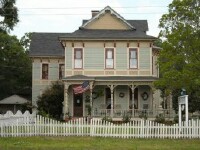
|
Brown-Bender House (Pride House) 409 E. Broadway This ornate, two-story, stick Victorian residence was built in 1888 by lumberman George Washington Brown (1854-1932), who later became involved in the oil and gas business. In 1928 Harrison County farmer John Griffin Bender (1871-1938), later Jefferson's road commissioner, bought the house and renovated it. The home remained in the Bender family until 1972. It features the original hardware, stained glass windows, doors, and intricate gingerbread trim. Recorded Texas Historic Landmark - 1983. UPDATE: The Brown-Bender House burned in 2013. |
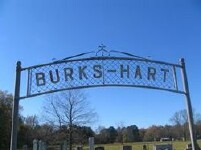
|
Burks-Hart Cemetery Description to come |
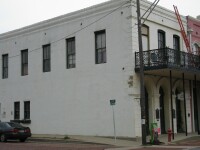
|
Business House, Nineteenth Century (Kahn Saloon) 123 W. Austin St. Fine structure with fanlight transoms. Housed Kahan Saloon in city's river port era. |
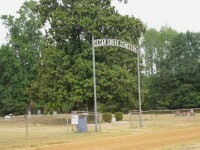
|
Cedar Grove Cemetery Description to come |
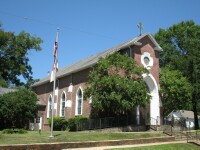
|
Christ Episcopal Church 1868. Parish instituted 1860. Rev. E. G. Benners first resident clergyman (1869-1894). Gothic architecture, lancet windows, scroll beams. |
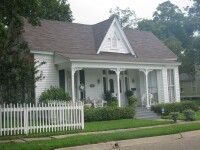
|
Clark, William, Residence 201 Henderson The original two rooms of this house, located in the back, are believed to have been built before 1852 by Jefferson's founder Allen Urquhart (1792-1866). Three rooms, constructed in the front, were joined to the earlier structure by William Clark (1848-1928), a local merchant who bought the house in 1885. A Presbyterian, Clark served as postmaster and county judge and in 1901 became the Grand Master of the Masonic Lodge in Texas. He lived here for 43 years. Recorded Texas Historic Landmark - 1981 |
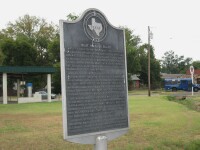
|
Confederate Civil War Meat Packing Plant Walnut and Polk Streets About 2 miles to the southwest, the meat plant of J. B. Dunn dressed,packed and shipped beef, pork and mutton to the Confederate army. In 1861 began by packing 150 beeves a day. Well located, on the Cypress Bayou shipping route, with cattle in trailing distance, in east and north Texas. Herds were bought at $20 to $40 a head. Used 42-gallon wooden barrels. Filled these with meat and brine. Obtained salt from New Iberia, La., and elsewhere through the Confederate government. Yet even with use of preservative salt, bloody water was sometimes found in the packed meat. The army complained it was made to accept this, though regular customers would have rejected it. The greater portion of cattle went out of Texas on the hoof, to be served as fresh meat after being slaughtered in the army camp. So much beef, pork, mutton, grain, sugar, salt, peas, beans, flour and corn meal was shipped away that Texas became known as the breadbasket of the Confederacy. Supplying of food was only one part of the Texas war effort, which included yielding her cotton crops as currency to buy guns and ammunition and other goods, and sending her mean and horses into the fight. |
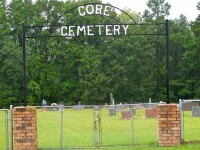
|
Core Cemetery Description to come |

|
Culberson, Charles Allen Description to come |
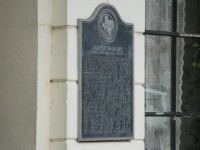
|
Dalhart, Vernon (April 6, 1881 - September 15, 1948) Born in Jefferson, Vernon Dalhart (Marion Try Slaughter II) began his career here at Kahn Saloon, starred later in operas in New York, and recorded for Edison's talking machine. His rendition of The Prisoner's Song (1924) was the first folk ballad to sell over a million records, and led to the rise of country music as an American art form. Dalhart is said to have made over 3,500 records, many under assumed names. Nostalgia for Jefferson echoed in his Caroline, Bully of the Town, and other hits. Within ten years he earned and lost a fortune, later living in obscurity. Incise in base: Marker sponsored by the Hoblitzelle Foundation. |

|
Deware, J. M., Residence, "Cavilier House" 202 East Dixon St. This early one-story Texas vernacular cottage was built sometime in the 1850s and was known as “the tavern” during the war, as it served as an overnight inn. It is unusual with its board and batten exterior wall finish. It has a seven-bay front porch with seven large supporting square columns, gable roof, and end chimneys of brick. At some later date, the porch structure was “updated” with gingerbread trim at the eaves and an open fretwork balustrade. The house was purchased at some time by Dr. R.E. Rowell. Later on, it was occupied by Capt. J.M. DeWare, Sr., who was married to Rowell’s daughter, Mary Francis (Mollie). His son, Jesse M. DeWare, Jr., inherited the home from his aunt, Lizzie Rowell Henderson, and lived there from 1945 until his death in 1965. This unique example of Texas vernacular architecture is a recorded Texas Historical Landmark and is recorded in the Historic American Building Survey in the Library of Congress. |

|
Douglas Cemetery Description to come |
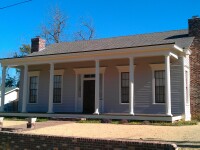
|
Duke, W.S., House "George Keese Home" 112 S. Friou St. This nicely proportioned and detailed Greek Revival cottage was built by Dan N. Alley, Sr., in 1858. It is believed that W.S. Duke, a Confederate veteran, purchased the home sometime between 1866 and 1870. Sometime later, the home was purchased by George W. Keese who resided in it for several years. The one-story, five-bay front home is of frame construction with Cypress clapboards, gable roof with plain wide cornice and returns, fluted Doric tetrastyle portico, rear ell with gable roof and three exterior brick chimneys. |
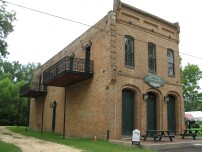
|
Early Jefferson Masonic Lodge Building 61 Dallas Street Built in the late 1850s, this building first housed the Jefferson Masonic Lodge. A number of businesses were located here during the Civil War, and later it was used by the Knights and Ladies of Honor of Myrtle and the Knights of Honor of Jefferson. Exhibiting elements of the Italianate style, this is the last remaining example of the commercial-row structures which served Jefferson's Dallas Street wharf front during its heydey as an inland port. |
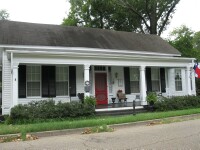
|
Emmert House 408 E. Jefferson St. Built about 1868 in late Greek revival style by George B. Draper. Victorian elements were added by later owners before 1898, when the house was purchased by Alice Emmert (1866-1925). Miss Emmert, who was one of the first women elected to public office in Texas, served as county superintendent of education, 1908-20. Claudia Taylor (Mrs. Lyndon B. Johnson) lived here, 1924-26, while attending school. The structure is still owned by an Emmert heir. Recorded Texas Historic Landmark - 1974 |
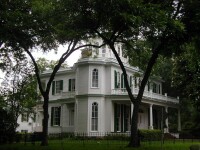
|
Epperson, Benjamin H., House "House of the Seasons" (McNutt) Built in 1872 for Benjamin H. Epperson, the House of the Seasons derives its name from the cupola with its stained glass windows that create an illusion of the seasons of the year. The home is a fine example of the transition period between Greek revival and Victorian styles of architecture. In plan and overall form, it is Greek revival. However, the detailing is Victorian with certain Italianate characteristics, such as the tall arched windows, the bracketed cornices, the gallery, the cupola, and the projecting bay windows. The circular opening in the first floor ceiling allows a view of the frescoes in the dome. Benjamin Epperson (1826-1878), a confidant of Sam Houston, was a distinguished lawyer, political leader, and entrepreneur. He served many terms in the Texas Legislature and was elected to the U. s. Congress in 1866, but did not serve because the southern delegations were not seated. When he built the house, Epperson was listed as one of the wealthiest men in the state and was respected as a major influence in Texas politics. Throughout most of its history, the House of the Seasons has served as a residence. It has also been used as a boarding house and as the main building of Jefferson College, a World War II veterans' college. |
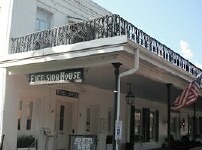
|
Excelsior House Hotel Oldest hotel in East Texas. Frame part built in 1850s; brick wing added 1864. Among famous guests during river port days of Jefferson were Presidents Grant and Hayes, and poet Oscar Wilde. Restored 1961-63 by Jessie Allen Wise Garden Club. |
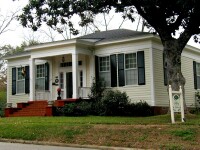
|
Falling Leaves - Sabine-Koontz House 304 E Jefferson St. Located in Jefferson’s Historic District, Falling Leaves is a gracious antebellum Greek Revival home. Built in 1855 by John Sabine, it is a recorded Texas Historical Landmark. The house features 12´8´ ceilings, a gasolier converted to electricity, lovely period antiques, a screened-in porch comfortably furnished with antique wicker, and afternoon refreshments served in a casual, relaxing atmosphere. A stroll about the property will reveal the huge magnolia tree planted by the original owners, a crepe myrtle that was planted about 1875, pecan trees that are a century old, and something blooming throughout most seasons. |

|
Federal Building 1869. First Federal Court and Custom House. Also housed county court and its records. |

|
Federal Court and Post Office Building 223 Austin St. Used 1890-1964 by Court of Eastern District of Texas. Now a museum. Recorded Texas Historic Landmark - 1966 |
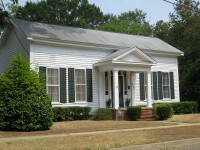
|
Figures House 407 E. Jefferson St. A typical East Texas Greek revival cottage, built in 1850s by Bartholomew Figures, who had been a local innkeeper. His son, James C. Figures, was later one of the many short-term owners. Mrs. Mary Eglentine Whitfield (1852-1941), a dressmaker, owned and occupied the structure, 1883-1928. Members of J. H. Benefield's family were owner-landlords, 1936-70. In 1970, it was sold to Mrs. Tommie Wurtsbaugh Glick, an artist, who has restored it. Recorded Texas Historic Landmark - 1973 |
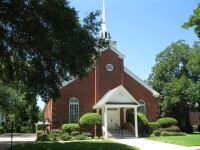
|
First Baptist Church Organized in 1855 as the Missionary Baptist Church, this congregation chose the Rev. George B. Tucker as its first pastor. Worship services were originally held in the Union House at city park, Freeman Hall, Judge Patillo's schoolhouse, and the Methodist and Presbyterian churches. The Rev. D. B. Culberson (1796-1862) served as the second pastor, 1857-1859. He was the father of Congressman David B. Culberson (1830-1900) and grandfather of Governor Charles A. Culberson (1855-1925). The fellowship erected a two-story brick church building on this property in 1869. It was the meeting place in May 1874 of the Southern Baptist Convention, with over 1000 in attendance. It was also the site of an 1877 revival led by Evangelist William E. Penn, a member of this congregation. In 1898 the fellowship split. Pat of the members formed Howelltown Baptist Church; the remainder continued to worship in the brick church until about 1917. The Howelltown congregation adopted the name Central Baptist in 1924. After the two groups reunited in 1937 as the First Baptist Church, members restored and reoccupied the 1869 structure. When it burned in 1944, a new church was erected. Educational facilities were added in 1951 and 1973. |
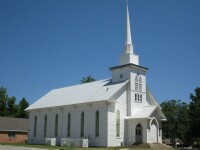
|
First Methodist Church Founded on this site, 1844. Rev. Jas. Baldridge, first pastor. Log church was replaced 1860 by most imposing brick one west of Mississippi River. Its bell, minted of 1500 Mexican silver dollars, now is in this building erected 1884. |
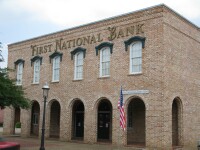
|
First National Bank of Jefferson Jefferson Square (Polk and Lafayette St.) Thomas J. Rogers (1832-1918), a native of Mississippi, came to Jefferson in 1856. After serving in the Civil War, where he attained the rank of captain, he returned here and in 1868 established a mercantile business in this block. In partnership with his son Ben F. Rogers, he opened private banking facilities in the store in 1896. Eight years later the private bank received a Federal charter, as the Rogers National Bank. Following the death of his father, Ben opened the Rogers State Bank and Trust at another site in this block. It closed in 1928 and was succeeded by the Jefferson Bank and Trust. Later incorporated as the Jefferson State Bank, it remained in operation until 1932. The Commercial National Bank, started in 1907, was also located here until 1920. During the economic depression of the 1930s, the Rogers National Bank remained sound. It was one of the first institutions to reopen without a special examination after President Franklin D. Roosevelt's 1933 closing of the nation's banks. A reorganization in 1950 resulted in the formation of the First National Bank of Jefferson. The present facility, constructed on the site of the original bank, is modeled after T. J. Rogers' building. |
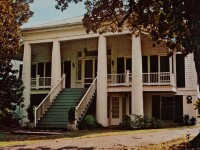
|
Freeman Plantation House This Greek revival plantation home was built about 1850 by Williamson M. (1807-66) and Drucilla (1812-65) Freeman for their children. A cotton and sugar cane planter, Freeman also operated a river freighting business. Materials use din construction of the house include hand-hewn timbers and brick made on the site. In the 1870s the residence was sold to R. E. Rowell (1826-1900), a former Confederate doctor, who later served as county treasurer. A rear wing was added to the home during the ownership of oilman L. S. Flannery (d. 1961), who purchased the property in 1937. |
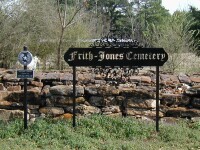
|
Frith-Jones Cemetery 24621 S.H. 49 W Frith-Jones Cemetery Established 1876. Historic Texas Cemetery - 2006 |
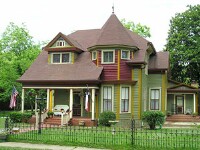
|
Gay 90's House (Benefield House) 1009 S. Line St. Drawing room held many social affairs when city was a leading port in Texas. Now J. M. Benefield Home. Recorded Texas Historic Landmark - 1966 |
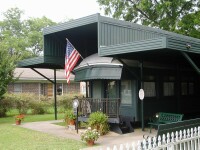
|
Gould, Jay, Railroad Car - "The Atalanta" Built in 1888 by the American Car & Foundry Company of St. Charles, Missouri, this was the private railway car of Jay Gould (1836-1892). A native of New York, Gould was a noted financier and the owner of numerous railroad companies, including the Union Pacific, The Missouri Pacific, the International & Great Northern, and The Texas Pacific. This car, named Atlanta, remained in Gould family ownership until the 1930s. Elaborately designed and elegantly furnished, the Atlanta features two observation rooms, four staterooms, two baths, a butler's pantry, kitchen, dining room, and office. Interior materials include mahogany and curly maple woodwork, silver bathroom accessories, and crystal light fixtures. Following Jay Gould's death in 1892, the car was used by his son, George Jay Gould (president of the Texas and Pacific Railroad), and his wife, actress Edith Kingston. The car later was brought to Texas from St. Louis and used as a family residence during the 1930s East Texas oil boom. Purchased in 1953 by the Jessie Allen Wise Garden Club, it was moved to this site in 1954. It remains a focal point in Jefferson's heritage tourism industry. |
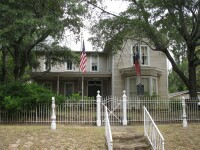
|
Graham, Capt. Charles G., Home 409 Delta St. Born in Tennessee, Charles Gibbs Graham (1833-1896) came to Texas in 1843 with his parents. He settled in Jefferson about 1850. During the Civil War (1861-1865), Graham served in the Confederate army, earning the rank of captain, and in 1864 was wounded at the Battle of Mansfield. Married in 1868 to Texanah Harris (1848-1927), he had three sons and one daughter. He became a prominent local merchant and cotton broker and in 1885 built this Victorian residence. In 1977 the structure had been continuously owned and occupied by three generations of the Graham family. Incise in base: Restored in 1973 by Mr. and Mrs. Kenneth Craver |
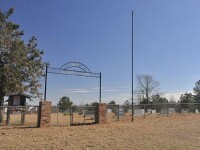
|
Gray Cemetery Description to come |

|
Greenhill Presbyterian Church Description to come |

|
Haggard, George E., Bldg. (RE 80) 123 W. Austin St. |
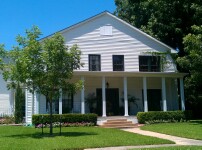
|
Haggard, George E., Funeral Home 203 East Clarksville St. The Captain William Perry House is a two-story frame Greek Revival residence of an unusual type for Texas. It was built in the late 1850s and remains one of Jefferson’s finest two story Greek Revival town houses, although an unusual type for Texas. It was originally located at Polk and Clarksville streets, but was later moved to its current location and incorporated into another structure. It has a side hall plan and off-center front door with a small attached flat-roofed porch with two square columns with molded capitals and two matching pilasters. The ridge of the pitched roof runs from front to back with the gable treated as a pediment. There is a wide entablature with deeply carved crown and bead moldings and frieze and architrave divisions with the second story windows cutting into the architrave. The windows are double-hung sash-type with six over six lights with molded frames. The exterior wall finish is clapboard. The verticality of the structure, the side-hall plan and the very rich, deeply carved detailing on the exterior are reminiscent of Greek Revival residences in New England and the old Northwest Territory. The builder of the home was Captain William Perry, who brought the first steamboat to Jefferson. Perry was from New Hampshire and lived in Jefferson until his death in 1869. He was best known as the original owner of the Excelsior House. |
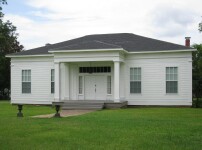
|
Hodge-Taylor House 1 mi. SW of jct. of US 59 and TX 49, W. Berry and Lavenia (Boggs) Hodge moved here from Kentucky and had this house built along the Daingerfield Road in 1852. Among their five children, son Robert Blount, of the 3rd Texas Cavalry, C.S.A., died from wounds in the Battle of Atlanta in 1864. Hodge, a prominent landowner and surveyor, sold the property to D.W.H. Taylor, buisnessman and publisher of the Jefferson Jimplecute. T.J. Taylor, Jr. restored the residence in the 1950s. The classically proportioned Greek Revival style home features a cypress exterior, a prominent portico, interior chimneys and large rooms flanking a central passageway. Recorded Texas Historic Landmark - 1964 |
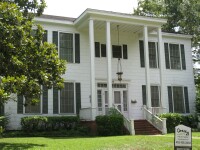
|
Homestead Built in 1851 by slave labor, square nails, broadax-hewn boards. Center society life of city. |
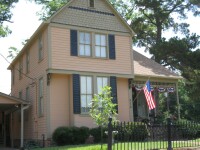
|
Houston Street Victorian Cottage (Wise Manor) 312 Houston St. Situated near ferry that brought riches to early Jefferson. First known owners (1851): John M. and Nancy Dollehite. A distinguished occupant: Mrs. Ernestine Sterne, 1872-1875 Jefferson postmaster. Restored by Mrs. Katherine R. Wise, owner since 1946. Recorded Texas Historic Landmark - 1970 |
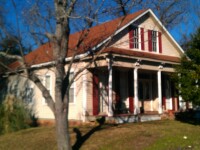
|
Hudgins-Blake House 1109 Line St. Residence with fine door and window styling; large rooms; 13' ceilings; wide board floors. Built during 1855-67 era, by William P. Hudgins, ;the house had a series of short-term owners before W. L. and Mattie A. Blake, prominent Jefferson Central (Negro) School teachers, bought it in 1897; their family owned it for 60 years. Restored by 1957 purchasers, Bill R. and Ella McDonald, house has been preserved since 1961 by Mrs. W. L. (Nellie) Jackson. |

|
Ice Factory in Texas, First 2 mi. west of Jefferson 1936 Centennial Marker - Established by Boyle and Scott about 1875. Sold ice at ten cents per pound. B.J. Benefield delivered it. The plant was later moved to Harrisburg. |
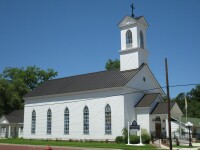
|
Immaculate Conception Catholic Church Church of oldest parish (organized 1866, by Father Jean M. Giraud, French priest) in Dallas Diocese. Among its charities have been three schools and first hospital in the Diocese. This edifice was built in 1867 of hand-finished wood, with tiered steeple, lancet windows. |
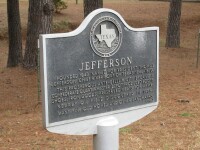
|
Jefferson 1 mi. NE on S.H. 49 Founded 1836. Named for President Thomas Jefferson. Chief river port of Texas, 1846-1870. This prosperous ante-bellum city became a Confederate Quartermaster Depot; produced boots, shoes, iron goods, preserved meats for army. Nearby oil field discovered in 1939. Many fine old homes and other landmarks. |
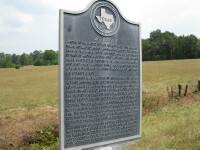
|
Jefferson 2 mi. south of Jefferson on US 59 Home to the Caddo Indians for centuries, this area of Texas attracted Anglo-American colonists to settle here in the early 1800s. Founded in 1839, Jefferson developed along a double-grid pattern. Daniel Nelson Alley platted the townsite in a true north-south and east-west pattern, while Allen Urquhart drew a plan with streets leading diagonally to and from Big Cypress Bayou. Jefferson was a center of commerce and an important shipping point on the Red River system. Riverboats arrived at the wharves daily, making it a major inland port of entry for Texas pioneers. It was the seat of Cass County from 1846 to 1852, and was named seat of the new county of Marion in 1860. During the Civil War Jefferson served as a major supply center for the Confederacy. The late 1860s saw the imposition of martial law by Federal reconstruction troops, and a devastating fire in 1868 destroyed much of the central business district. Destruction of a massive logjam on the Red River in November 1873 diverted the river's flow and lowered the water in Big Cypress Bayou. The decline of Jefferson's economy due to the loss of its port continued until 20th-century tourism began to revive the town. (1990) |
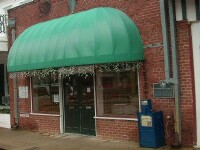
|
Jefferson "Jimplecute" Initials of words "join industry, manufacturing, planting, labor, energy, capital (in) unity together everlasting" headed 1848 paper of E.C. Beazley. Ward Taylor (1832-1894) founded present Jimplecute, published 1865-1926 by his family. Later owners: Mrs. H. P. Winsborough, Tom Foster, Arthur M. Bower, Mr. and Mrs. Tom Hicks, Mr. and Mrs. Dwaine Dennis. |
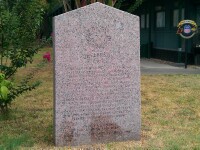
|
Jefferson C.S.A. (Civil War) 200 block of W. Austin St., beside Gould Car (Star and Wreath) Metropolis of commerce and culture for East Texas, Jefferson became important center for Confederate activity. Major quartermaster depot for northern Texas established 1862 supplied clothing and camp equipment. Cotton Bureau Station set up to buy cotton, "life blood of the Confederacy." Two iron works in county made plows, kettles, skillets and cannon balls. Thousands of cattle and sheep were driven to slaughter house for processing and shipment. Boot and shoe factory helped outfit army. Debarkation center for troops leaving Texas. A memorial to Texans who served the Confederacy. Erected by the state of Texas 1963. |

|
Jefferson Historical Society and Museum Description to come |
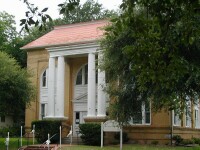
|
Jefferson Carnegie Library Built 1907 by local funds plus a gift from Andrew Carnegie Foundation-- one of 34 such grants made in Texas (where the movement for public libraries had begun in 1881). A center of interest in a culture-loving town. |

|
Jefferson Ordnance Magazine On the Big Cypress River This historic powder magazine was constructed during the Civil War to safely store powder and munitions. The single room, square, brick building's structural design focused on security and ventilation. Complete with a light roof to bear the bulk of the force should an explosion occur. On April 14, 1865, Federal troops took over the buildings and used them for troop encampment. The remains of two similar powder magazines were also discovered near this site. This magazine is the only freestanding ordnance magazine in Texas and one of the few remaining in the U.S. Recorded Texas Historic Landmark - 2011 |
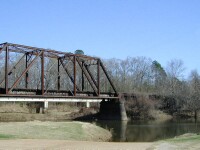
|
Jefferson Turning Basin N. side of bridge on Polk St. Wide, deep lagoon in Cypress Bayou, used for turning around ships in Gulf-Red River trade. First steamer to reach here was the "Lama" in 1844, by way of Red River, which for 200 miles above Shreveport was clogged by a "raft" of debris that had begun forming about 1529. Cypress Bayou thus was best travel route into Oklahoma, western Arkansas and north Texas. Until Federal government in 1873 removed the raft, Jefferson was southwest's greatest inland port, with this basin its business center. Last steamer operated here in 1903. |

|
Judea Cemetery Description to come |

|
Kahn Saloon Building (George E. Haggard Building) Built during the early 1860s, this structure served as a boarding house and as a mercantile before opening as the Kahn Saloon about 1900. Temperance movement leader Carrie Nation was denied entrance here during one of her campaigns through Texas. Jefferson native Marion Try Slaughter launched his career as country music singer Vernon Dalhart at the Kahn Saloon. The popular gathering place was closed after local prohibitionists won a 1907 election. Since that time, the building has been used for a variety of purposes, including a newspaper office, lodge building, furniture store, and funeral home. |
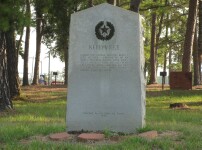
|
Kellyville 1936 Centennial Marker - Named for George Addison Kelly, who died in 1909. Proprietor of an early foundry which cast cowbells, widely used by ox-team freighters. After 1860 his factory turned out the first modern plows used in Texas. |
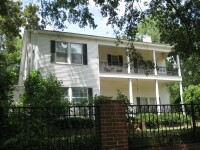
|
Knightwood 201 E. Walker St. Knightwood was built in 1852 by Henry A. Mims, who later served in the Confederate army. In 1855, it was purchased by Douglas Wise and remained in the Wise family for 60 years. Jessie Allen Wise, the founder of the Garden Club, lived here during that time. In the late 1890s, the house was the meeting place for the Men’s Harmony Club and the Ladies’ Cooking Class, plus dancing parties were held weekly. |
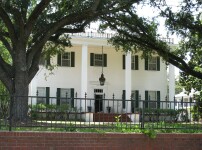
|
Lester, Ruth, Home "Guarding Oak" 301 S. Friou St. This home as originally built in 1859 was a story-and-a-half structure of Greek revival style. The property was originally purchased from Dan N. Alley, Sr., in 1859. Records indicate that George T. Todd, a Confederate veteran and prominent Jefferson citizen, purchased the home in 1866. In subsequent years, the home changed hands many times and was eventually converted to apartments. After a fire destroyed the upper section of the house, Mr. and Mrs. Dan Lester purchased it in 1941 and renovated it into its present Full-Facade Neoclassical style structure that was in vogue from about 1900 until 1950. Although the home was vastly remodeled in 1941, the lower portion of the structure remains as originally constructed and exhibits the construction techniques typical in East Texas in the mid-nineteenth century. |

|
Liberty Baptist Church This church traces its history to April 1874, when eight charter members gathered to organize a Baptist congregation. The first pastor was W. W. Mond. Early worship services were held in a Union Church building which was shared with the local Methodist congregation and was also used as a school. Known as Harmony Baptist Church in the early 1890s, the original name of Liberty was restored in 1898. About that time the Methodist congregation ceased to use the Union Church facility, which has been enlarged over the years to accommodate the growing Baptist congregation. |
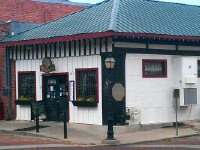
|
Livery Stable Near Trammel's Trace, a road charted 1813, used by thousands of settlers migrating to Texas. Site was owned 1868 by D. B. Culberson, later a congressman and a lawyer for defense in the Diamond Bessie murder trial. Culberson's 2-story building here was original site for the Chesterfield Club, East Texas' elite social group, 1870s-1930s. Present structure, built about 1900, housed horses and buggies for public hire until auto age. |
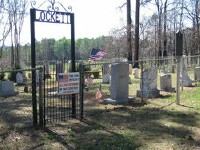
|
Lockett Cemetery Royal and Martha (Smith) Lockett came to Texas from Georgia between 1856 and 1858 with their eleven surviving children and the family's slaves. Seven of their eight living sons survived in the Confederate Army. The earliest marked grave on this site is that of Walter R. McGarity (1853-1862) son of James H. and Marie Antoinette (Lockett) McGarity and grandson of Royal and Martha Lockett. Six generations of Lockett descendants are interred here. according to family oral history, a Union solider who died on the Lockett Plantation also is buried in the graveyard. Of the more than 45 interred here by 1999, two were verterans of the Confederate Army and three were veterans of World War ll. The Lockett Cemetery continues as a chronicle of Marion County history. |

|
Macedonia Cemetery Description to come |
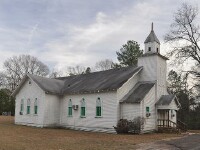
|
Macedonia United Methodist Church Following the Civil War and emancipation, freed slaves began to see the need for a place to collectively worship and gather. As a result, newly freed slaves in Western Marion County decided to organize a church under the leadership of Henry Smith. The first meeting place was located on a plot of land called “the Leigh High Hill” owned by Leigh High, a white settler in the area. According to local testimonials, the church was officially organized in April 1872. The group named themselves Macedonia Methodist Episcopal Church. Henry Smith was the first pastor. In 1874, Paul Mathis, a member of the church, decided to organize a school within the church. After two years, the school, named Macedonia, relocated to the private residence of John and Mahala Hall. By 1910, the school was again relocated to the church campus. In 1891, the membership erected their first building on the Halls’ land, a few hundred feet south of the present location. Several years later, this building was destroyed by fire. In 1908, the church purchased two acres of land from W.B. Ward and a new building was erected. Additional land was purchased in 1920 and the church building was rebuilt in 1940 to accommodate increasing membership. As a result of the depression and World War II, membership began to decline. In 1968, Lodwick and Smyrna Methodist Churches merged with Macedonia and attendance rose. The church was renamed Macedonia United Methodist Church. Along with building improvements, a fellowship hall was added for dinners, meetings and events. Macedonia United Methodist Church continues to have a strong presence in the community. |
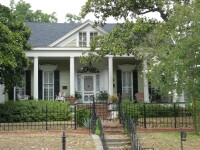
|
Magnolias, The Broadwy and Friou 1867. Built by Lucy Ann, wife of Dan Alley, donor of half of Jefferson's townsite. Near 100th birthday, house retains fine style. Has handmade columns, massive hewn sills, wide pine board floors. Here was organized 1881 Club, oldest member and pioneer unit in Texas State Federation of Women's Clubs. Also (on Feb. 22, 1955) birthplace of Martha McCraw Chapter of the D. A. R. Recorded Texas Historic Landmark - 1965 |
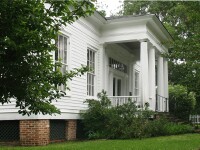
|
Manse, The 221 E. Delta St. This classic home is the finest example of Greek Revival architecture in Jefferson and possibly in East Texas. It sits on a corner lot and is “double-faced” with a tetrastyle portico facing each street. It is a one-story wood framed structure with clapboard siding and is “raised” on a brick foundation wall. The shape of the home is simple, being a rectangle with a hipped roof and with hipped roof extensions over the porches. A full, deep entablature extends around the entire home and is supported by fluted, Doric columns at the two porticos. The Manse is named the oldest house in Jefferson because the first two rooms are said to have been built in 1839. The two rooms on the east side of the central hall are those rooms. Sometime in the 1850s the home was expanded to the current style and shape. |
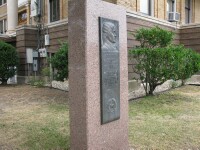
|
Marion County County Courthouse, Austin and Polk Streets 1936 Centennial Marker - Early navigation headquarters on Cypress Bayou. County Seat of Marion County since 1860. Before water transportation was superseded by railroads during the seventies this city, in the midst of a prosperous plantation area, was the business center of Northeast Texas. |
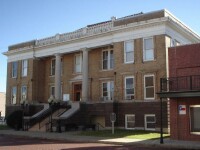
|
Marion County Courthouse The Texas Legislature created Marion County in 1860. Jefferson, established as early as 1841, was chosen as county seat. By 1860, Jefferson was a regional economic center for steamboat traffic on big cypress bayou, navigable due to a logjam on the Red River. The County Government occupied several buildings during its first 50 years, including a courthouse built in 1873 and the Murphy Building, used today as a courthouse annex. In 1912, the county hired architect Elmer G.Withers to design a courthouse. Similar to his design for the Roberts County Courthouse, this classical revival building features Doric columns, balustered parapet, denticulation and raised basement. |
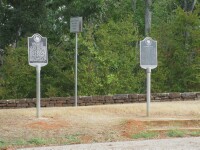
|
Marion County Depression Era Roadside Park Description to come |
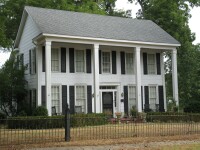
|
Rogers-McCasland, Home, "Captain's Castle" 403 E. Walker St. In 1874, the Thomas J. Rogers family moved into a small house at the corner of Walker and Alley streets. As his family grew, he needed a larger home. Between 1876 and 1878 he moved an older, two-story house to the site of his home and attached it to the front porch. The older, 1850s structure was moved on the site on large cypress log rollers, pulled by oxen, from the Dallas Street area that was well-known as a red-light district. It was said to have been used as a "bawdy house." The Rogers-McCasland House, today known as the Captain’s Castle, is an imposing landmark of Tennessee Planters architecture. |

|
Meadows Cemetery Description to come |
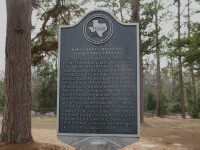
|
Mims Chapel Methodist Church and Cemetery This church was organized by pioneer area settlers before the Civil War. The first building here was a log structure known as the Rock Church because of a large nearby rock where early meetings were held. The church was later named Mims Chapel Methodist Church in honor of brothers John w. Mims (1829-1907) and Henry Mims (1839-1915), who were instrumental in securing this site for the congregation. Graves in the cemetery date from the 1870s and include prominent early community leaders. A schoolhouse here was in use until about 1906. |

|
Monterey Cemetery Description to come |

|
Moseley Cemetery Description to come |

|
Moseley, J.B., Home Description to come |
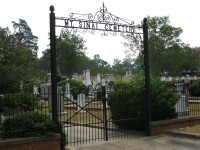
|
Mt. Sinai Cemetery Description to come |
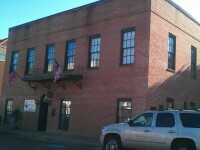
|
Murphy Building Brothers John C. Murphy (1816-71) and James M. Murphy (b. 1820) of Tennessee came to Jefferson, Texas, in 1850. They owned a wholesale cotton firm and were prominent businessmen. In the early 1850s they built this structure as a warehouse in the riverfront district. In 1884 the building was remodeled for county offices and courts. In 1915 it became the city hall, with space for the Chesterfield Dance Club and the Jefferson Volunteer Fire Department. A Diebold safe, installed in 1877, continues to serve the building, again used for county offices. |
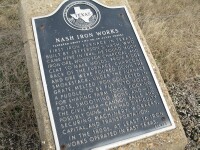
|
Nash Iron Works First iron furnace in Texas. Built by Jefferson S. Nash, who came here in 1846. He found much iron ore, wood for charcoal, and clay to make molds. From ridge back of the furnace, charcoal and ore were poured down the smokestack. Under the furnace grate, melted iron collected in a puddle, to be put into molds for shaping farm tools, cooking pots, smoothing irons, and-- in the Civil War-- cannon balls and possibly guns. Nash had difficulty securing machinery, workers, capital, and transportation. In the 1800s, at least 16 iron works operated in East Texas. |

|
New Zion Cemetery Description to come |
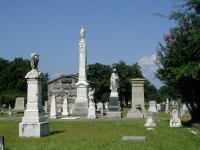
|
Oakwood Cemetery Description to come |

|
Old Foundry Cemetery Description to come |

|
Perry, Captain William House 203 Clarksville St. The Captain William Perry House is a two-story frame Greek Revival residence of an unusual type for Texas. It was built in the late 1850s and remains one of Jefferson’s finest two story Greek Revival town houses, although an unusual type for Texas. It was originally located at Polk and Clarksville streets, but was later moved to its current location and incorporated into another structure. It has a side hall plan and off-center front door with a small attached flat-roofed porch with two square columns with molded capitals and two matching pilasters. The ridge of the pitched roof runs from front to back with the gable treated as a pediment. There is a wide entablature with deeply carved crown and bead moldings and frieze and architrave divisions with the second story windows cutting into the architrave. The windows are double-hung sash-type with six over six lights with molded frames. The exterior wall finish is clapboard. The verticality of the structure, the side-hall plan and the very rich, deeply carved detailing on the exterior are reminiscent of Greek Revival residences in New England and the old Northwest Territory. The builder of the home was Captain William Perry, who brought the first steamboat to Jefferson. Perry was from New Hampshire and lived in Jefferson until his death in 1869. He was best known as the original owner of the Excelsior House. |

|
Perry, Captain William Description to come |

|
Plantation House 1854 Plantation house shows European styling in brick ground floor, frame upper stories, double iron stairways. |
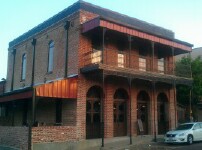
|
Planter's Bank Building & Warehouse 1852. In Jefferson's heyday, riverfront warehouse of firm with St. Louis, New Orleans branches. |
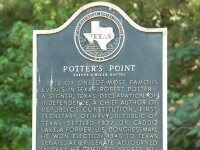
|
Potter's Point Site of one of most famous events in Texas. Robert Potter-- a signer, Texas Declaration of Independence, a chief author of Republic's Constitution, first Secretary of Navy, Republic of Texas-- settled 1837 on Caddo Lake. A former U. S. Congressman, he won election 1840 to Texas Senate. After Senate adjourned in 1842 he tried to arrest his political foe, William P. Rose. On night of March 1, 1842, Rose led armed men to Potter's home. At dawn Senator Potter jumped into the lake to swim for help, but was shot to death. He is buried in State Cemetery, Austin. |

|
Presbyterian Church Built 1872 for congregation organized earlier. Once the largest Cumberland Church building in Texas. Has a specially cast bell. Painted clock faces on the steeple show the hours for Sunday School and morning and evening worship. |

|
Presbyterian Manse (Rogers Home) Built in 1850s. Home of Capt. T. J. Rogers, founder and president, private bank. Restored by Judge and Mrs. Joe McCasland. |
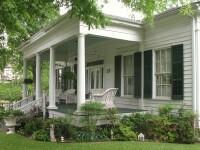
|
Preston Home (Moseley Manor) 412 N. Soda Built mid-19th century by J. C. Preston, pioneer druggist. Home of Judge Seborn Moseley and his descendants. Recorded Texas Historic Landmark - 1966 |
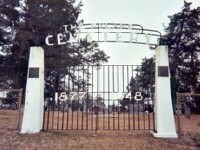
|
Pyland Cemetery Description to come |

|
Rainey, S. D., Home Built 1880 by cotton factor S. D. Rainey. Style: midwestern rococo. Since 1886 a center of social life, as R. S. Terry Home. |

|
Rand Cemetery Description to come |

|
Red River Warehouse 1852. Headquarters, New Orleans Shipping, 1860-1870, when Jefferson was 2nd largest Texas port. |

|
Rosebud Saloon 1854. Rendezvous of judges, lawyers and men with notched guns. Partly burned 1902. Restored 1946. |

|
Rowell Family Home (See also Rowell-Deware House) Early clapboard cottage with ornate trim. Once a tavern; since 1856 in Dr. R. E. Rowell family; known as DeWare home. |

|
Rowell, A.H., House Built about 1862 by civic leader, Q. Bateman. Bought by A. H. Rowell 1884. Still has gaslight fixtures, other relics. |
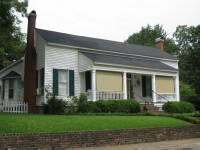
|
Rowell, J. H., Home 301 S. Alley St. The Rowell House was built in 1858. In 1879, the home was purchased by J.H. Rowell, Sr., a Confederate veteran from Alabama and one of three Rowell brothers to settle in Jefferson. The home is an early Texas vernacular structure with simplified Greek Revival influence with a three-quarter front porch and exposed brick chimneys at each gable end. The plan of the house consists of a central hall with flanking parlors. The original rear door opened onto a long side porch which connected to a detached kitchen. In 1974, the house was donated to the Jefferson Historical Society and Museum by the then current owner, Mrs. Beth Rowell Mead, a granddaughter of J.H. Rowell. The house is now a private residence. |
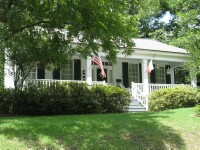
|
Sagamore - Herbert Sanlin House 201 Dixon St. The Sagamore House, a Texas frontier-style cottage in the Greek Revival style built in 1852, originally consisted of a main house with two large rooms and two bedrooms; this was considered the “second generation” of the popular “Frontier House” found throughout the South and Southwest. Original Frontier Houses had two rooms on either side of the central hall or “Dog Trot.” The Sagamore “Dog Trot” was never open according to an 1868 rendering. The kitchen and bathroom were housed in out buildings, which were eventually moved to the main house and attached to it. As the legend goes, through the years owners were plagued with sagging floors in the home. When the Hubert Scantlin family bought the house in the 1940s, they vowed the house would “sag no more” after they repaired it, and the name stuck. Sagamore was featured on the original Dogwood Trail Tour in Jefferson, which later evolved into the Historic Pilgrimage held every May. |

|
Savannah Cemetery Description to come |
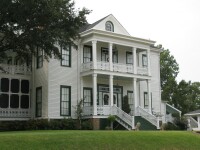
|
Schluter Home Taylor at Line St. Colonial home built 1856 by F. A. Schluter, one of first 6 settlers in Jefferson. Has spacious halls, wide galleries. Recorded Texas Historic Landmark - 1965 |
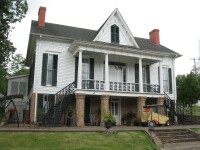
|
Sedberry House 211 N. Market St. Little is known about the original builders who constructed this house in 1853 for John and Mary Morgan. They lived there just two years and sold it to W.F. Smith, and for the next eight years it was known as the “Smith Premises.” It was sold at Smith’s death. At the beginning of the Civil War, it was purchased by J.A. Carpenter, editor of the Confederate News. The house changed hands several times, until it was acquired by George and Lelia Sedberry, second wife of W.L. Sedberry, and it remained in her name until her death. |

|
Sedberry, Mrs. Ruth, Home Description to come |

|
Simmons Cemetery Description to come |
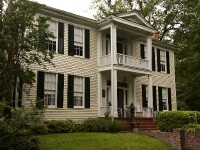
|
Singleton Family Home 401 N. Soda St. The Singleton home, built in 1859 by Buckner Abernathy, is a Greek Revival home located in the older portion of Jefferson. B.J. Terry and George McFarlane were also early owners of the home. McFarlane was an engineer for the MK&T Railroad and was the first railroad engineer to run a train from Jefferson to New Orleans. The home was purchased in 1885 by W.E. Singleton, Sr., a Confederate veteran, and it remained in the Singleton family until 1985. The last family member occupying the home was Mrs. Elli Mae Moseley, a grand-daughter of Singleton. The home is an excellent example of early Texas Greek Revival architecture that was patterned after 18th Century Virginia houses of the cross plan, hence the sobriquet “Virginia Cross.” The home’s distyle, two story front portico with a gabled pediment and second floor balcony supported by classical columns is unique in Jefferson. Inside, the large central hall features pairs of doors at the front and back that provided cross ventilation in early times. The Virginia Cross is constructed of Cypress lumber and the exterior walls are covered with Cypress clapboards. The floors are original wide plank, pine floors. The parlor and central hall feature period wallpapers. |
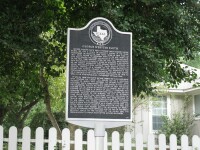
|
Smith, George Webster 403 W Lafayette St. George Webster Smith was a former union soldier whose beliefs set off a chain of dramatic events in the tense atmosphere of post-Civil War Texas. Born in New York in 1841, Smith moved to Michigan early in his life. When the Civil War started, he joined his uncles in the 123rd Regiment of the New York Infantry. After the Civil War, Smith moved with an uncle to Jefferson, where he acquired a reputation as an ardent Republican and became heavily involved in local Reconstruction efforts. Smith became active in politics, serving as a member of the voter registration board for Marion County, which was responsible for disenfranchising former confederates. He was also elected as a delegate to the Constitutional Convention of 1868, as well as the state Republican convention the same year. It was in 1868 that Smith became embroiled in an argument with Colonel R.P. Crump. This dispute led to a shooting incident in which two members of Crump’s party were wounded. Smith surrendered and was placed at this site in the Calaboose, the city jail which opened in 1867. The mayor assured him he would be protected by guards, but on the evening of October 4, a group of about 70 disguised men disarmed the guards and assassinated Smith, as well as two freedmen. Because of the murders, the city of Jefferson came under martial law, and some officials, including the mayor, were replaced. Twenty-three men were brought to trial in 1869, with three convicted of murder and sentenced to life terms, and other convicted of lesser charges. Smith’s death was noteworthy as a symbol of the deep and often violent racial divide in Texas after the Civil War, and as the event that marked both the beginning of federal troop withdrawal from Jefferson and the end of the terror brought about by the Knights of the Rising Sun, the organization to which many of the accused belonged. (2006) |

|
St. Louis Commission Company Warehouse Description to come |
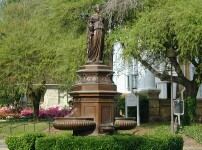
|
Sterne Fountain Market & Lafayette Streets Settling in Jefferson prior to the Civil War, Jacob and Ernestine Sterne became prominent leaders of the community. Their early management of the post office here and their involvement in civic and cultural activities reflected the dramatic influence Jewish families had on the development of Jefferson. In 1913 the Sternes' children gave this fountain to the city in honor of their parents. Designed for use by people and animals, it was cast by the J. L.. Mott Foundry of New York. The work of Guiseppe Moretti, it features a statue of Hebe, the Greek Goddess of Youth. |
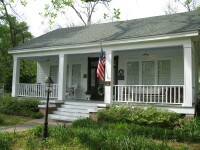
|
Stilley-Young House, "The Grove" 405 Moseley St. The story of The Grove dates back to 1860, at the marriage of Minerva Fox and Frank Stilley. Minerva lived on the Fox plantation in Marshall, where her family had farmed cotton for generations. Frank Stilley was a young businessman from Louisiana who had taken up residence in the riverport of Jefferson, where he plied his trade as a cotton factor. The two met and were married, and Minerva’s father built them the current house on Moseley Street as a wedding gift for the couple. The outside of the house has classic Greek Revival lines, but the inside still shows some of Stilley’s influence of Creole architecture, demonstrating Jefferson’s ties between the Old South and New Orleans influence. On March 6, 1885 Charles J. (“Mr. Charlie”) and his wife Daphnie Finch Young purchased The Grove property. Mr. Charlie operated a barbershop downtown on Austin Street. The Young family soon established themselves as leaders of the African-American community in Jefferson. In 1902 when Daniel Alley deeded the space for an African-American cemetery, Mr. Young was one of the Trustees for Cedar Grove Cemetery Association. The Stilley-Young House is one of the few private homes demarked on the map used in the Stockade Trial that took place during Reconstruction in Jefferson, so it clearly played a part in that chapter of Jefferson’s history. |
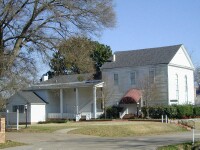
|
Synagogue: Sinai Hebrew Cong. of Beth-El, 1876 Description to come |

|
Taylor Cemetery Ward Taylor, Sr. (1791-1871, and Nancy (Mathews) Taylor (1796-1879) came to Texas from Alabama in 1845. Several Taylor and Mathews relatives and children joined them in Marion County in that year and the years following, building homes and helping to settle the area. In May 1860, four-month-old Emmett, son of E. W. and S. E Taylor, was buried on this site on land belonging to Marion DeKalb (M. D. K.) Taylor. Emmett's grave remains the earliest marked burial in the cemetery, though family history indicates that the graveyard was in use before the Civil War. According to legend, the family buried several slaves outside the original fence to the north of the main cemetery. When M. D. K. deeded the land to his father, Ward Taylor,Sr., in 1868, the family cemetery was mentioned in the deed. Ward's wife Nancy inherited the property upon his death. She left the property, according to Ward's instructions, to their son J. M. Taylor, who willed it to his wife Amanda Maleson (Craven) Taylor. In 1961, a cemetery association was formed to care for the graveyard. Association members identified sixteen of those who are believed to have been buried in 32 unmarked graves. In 1998, there were 32 marked burials in Taylor Cemetery. The graveyard continues to serve Taylor descendants and all others who wish to be buried here. |

|
Taylor, T. J., Jr., Home (see also Hodge-Taylor House?) Description to come |
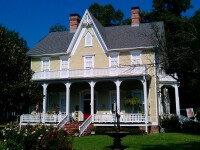
|
Terry, R.S., Home 109 W. Henderson St |

|
Terry, W.S., Home 404 N. Walnut St Once the residence of B. J. Terry, Grand Master of Masonic Lodge of Texas. Built before 1850. Recorded Texas Historic Landmark - 1966 |
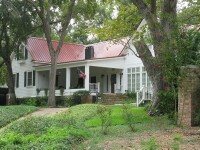
|
Thurman Place 207 S. Alley One of oldest homes in city. Begun about 1857 while site was owned by "Major" P. M. Graham, land dealer, surveyor, and merchant, who was original clerk of Cass County (then encompassing town of Jefferson), 1846; postmaster, 1849. The place was bought 1859 by merchant Theo Nichols, who in 1882 gave it to his daughter, Mrs. Samuel Thurman. The Thurmans had a deer park on west side of the block, lived here until 1906, and gave property its lasting name. Recorded Texas Historic Landmark - 1972 |
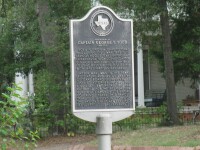
|
Todd, George T. 505 N. Polk St. (1839-1913) Born in Virginia. Came to Texas 1843. During Civil War, served in famous Hood's Texas Brigade. At Chickamauga, took command after Gen. Hood was shot. In 1864-1865, fought west of the Mississippi with Lane's Partisan Rangers. After war, was in the Texas Legislature and on University of Texas Board of Regents. As district attorney, prosecuted Cincinnati jewelry salesman Abe Rothchild for the 1877 roadside murder of "Diamond Bessie" Moore. Covering 7 years, this famous trial put in conflict some of the nation's best lawyers and set numerous legal precedents. |
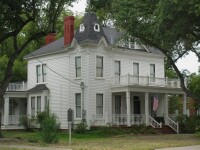
|
Todd, George T., House 505 N. Polk St. Capt. George Todd (1839-1913) was a Confederate veteran, ex-district attorney, former state legislator, and senior member of East Texas Bar. He built this home in 1893 for his family: wife Marion (Miller); sons Van Dyke, A. Miller, Charles C., and William H.: and daughters Eva C., Mary V. (later Mrs. J. S. Lewis), and Lula D. (later Mrs. L. E. Hough). Architecture is late Victorian featuring a corner tower with mansard roof. Descendants still own and preserve the structure. Recorded Texas Historic Landmark - 1974 |

|
Todd-Terhune House, "Secession Hall" 310 E. Jefferson St. In 1856 or 1857 C. S. Sabine built this Greek revival house with its large central hallway. In 1858 the residence was sold to District Judge William S. Todd (1808-1864), who attended the Secession convention of 1861. The dwelling was occupied from 1869 to 1912 by the family of Dr. Archibald A. Terhune (1825-1891), popular local physician. He added a small room on the east side of the house for his office. His wife Mary Frances (Ware) (1831-1904) was a noted gardener. |
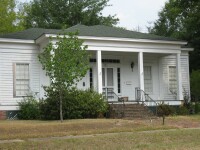
|
Torrans-Clopton-Spellings House 107 E. Clarksville William P. Torrans (1818-1881) built this Greek revival structure on Lafayette Street in the 1860s. It was purchased in 1877 by druggist E. W. Taylor (b. 1838), a former mayor of Jefferson, and Anna Matilda Clopton (1838-1916), wife of Dr. Albert G. Clopton (1838-1916), who had his office here. After 1882 the residence was moved to this site by Soloman A. Spellings (1841-1903), a Confederate veteran who operated a livery business on Polk and Henderson streets. Additions were made in 1932 and 1947 during the ownership of grocer Hosea D. Watson (1879-1957). |
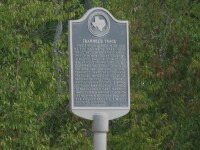
|
Trammel's Trace Depression Era Roadside Park Traces began as foot paths used by the Indians to mark their trails through wilderness areas. They later were used by surveyors in mapping early land grants. In 1824 Nicholas Trammel (1780-1852), a government scout, began opening up the trace that now bears his name. Trammel's Trace was, for many years, an important route of immigration into Texas. Approximately 180 miles long, it began at Fulton, Arkansas, and continued to Nacogdoches, Texas. Trammel's Trace entered Marion County on its northern boundary and left the county about 3.5 miles south of Jefferson. |
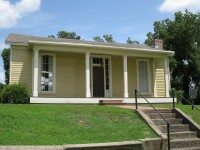
|
Trehune, Sarah, House "The Marsh Place" 202 S. Friou St. The Marsh Place was built in 1860 by Dan Parks. In 1861, it was purchased by S. Marsh and although the Marsh family only lived in the house for 13 years, it has forever been known as The Marsh Place. Other early owners of the house included Mrs Bettie Waterhouse Parsons, the sister of General Richard Waterhouse and Mr & Mrs H.C. Taylor. Sarah Terhune Taylor was a socially prominent charter member of the 1881 Club, one of Texas’ oldest women’s clubs. The home is a typical one-story East Texas Greek Revival cottage with a simple gabled roof structure and with a central hall floor plan. All of the floors are original heart pine, 6 inches wide. The home is a Recorded Texas Historical Landmark. |
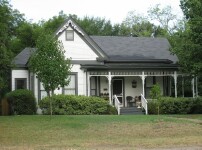
|
Urquhart, A.M., House Description to come |

|
Valley Plains Cemetery Description to come |
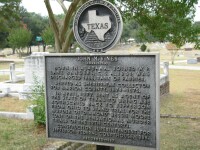
|
Vines, John M. Oakwood Cemetery (1844-1914) Born in Alabama. Joined W. P. Lane Rangers, C. S. A., 1861; was discharged 1865, rank of farrier. Served as sheriff-tax collector for Marion County, 1874-1876. In April, 1877, sent as agent of the state of Texas to bring Abe Rothschild back to Jefferson from Ohio to stand trial for the murder of "Diamond" Bessie Moore (one of the sensational murder trials of the 19th century.) Construction superintendent for Jefferson Federal Courthouse, 1888. |

|
Walker, R.B. Description to come |

|
Waterhouse, Richard (Star and Wreath) (January 12, 1833 - March 20, 1876) Native of Tennessee, participant in United States war with Mexico, Texas businessman, colonel of the 19th Texas Confederate Infantry, commended for gallantry at Milliken's Bend during Vicksburg Campaign, fought at Mansfield and Pleasant Hill during Red River Campaign, brigadier-general in Confederate army. |

|
Webb Cemetery Description to come |

|
Whatley Cemetery Description to come |

|
Wilkinson Cemetery Description to come |
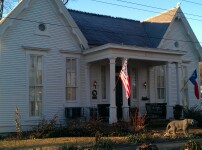
|
Woods, Perry M., House "The French Townhouse" The neoclassic front doors of the house and all twelve tall windows were imported from France. The gable eaves are trimmed in vernacular crown and teardrop detail, and it has a high-pitched roof with a dragon-cut tin ridge cap. |